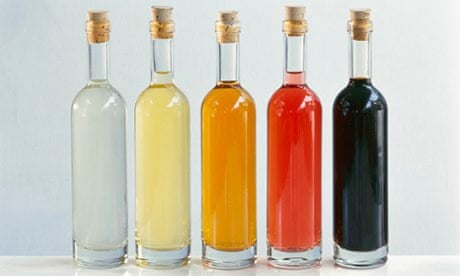
If you have been following this blog for a while and pay attention to the recipes, than you know I am a heavy user of vinegars in my cooking.
Vinegar has to be one of my favorite condiments. There are so many types of vinegar, it adds so much flavour, and is essentially calorie, fat and sodium free! Vinegar also has positive effects on blood sugar, some varieties contain anti-oxidants, and there is some evidence it may even have anti-carcinogenic properties. Oh, and it also makes a great non-toxic cleaner for around your house.
Here is a general guide how to use different kinds of vinegar (provided by Whole Foods):
Asian vinegar: While early Westerners were fussing over sour wine, the Chinese and Japanese were perfecting the art of making vinegar from alcohol created from whole grains. Choices in this category—which includes rice and plum vinegars—range from quite savory to mild and sweet so experiment with using them in salad dressings, sauces, or as condiments on fish, vegetables and grain dishes.
Balsamic vinegar: The tradition of this beloved sweet Italian vinegar deserves a full page unto itself. But we know your time is important, so we'll cut to the chase. Genuine balsamic vinegar is made by artisans in the towns of Modena and Reggio, Italy from unfiltered, unfermented grape juice. It's aged for many years, sometimes for even more than a century. These days it's splashed on everything from salads and cheese to ice cream and cake, and we don't mind a bit.
Cider vinegar: Cider vinegar is the product of yeast-fermented apple juice, giving it a decidedly apple-like aroma and golden color. It's a great choice for mixed fruit and vegetable salads, marinades, chutneys and other robust condiments and pickles.
Distilled vinegar (a.k.a. white vinegar): The most popular vinegar in the U. S. It's used commercially for pickles, salad dressings and mustard. It's no secret that it's great for cleaning, too.
Herb vinegar: Herb vinegars are made by steeping herbs—such as rosemary, basil or oregano—in vinegar, imparting herbal flavors later on to delicate sauces and vinaigrettes.
Malt vinegar: Unhopped beer—i.e. cereal grains and sprouted barley—is the source for malt vinegar. It's popular in Britain and Canada as a condiment for fish and chips, but don't underestimate its value for pickling, too.
Sherry vinegar: This artisanal vinegar has much in common with balsamic vinegar since it's dark and intensely flavored, with a sweet aftertaste. It's a terrific choice for fruit salads or vegetable salads featuring cheese.
Wine vinegar: The very best wine vinegars — white or red — are still made using the ancient Orléans process, requiring a lot of patience. Some commercially produced wine vinegars are not made from wine at all but from yeast fermented grape juice.
Personally, I tend to use cider vinegar for Mexican/Tex Mex and Indian dishes (in place of lemon juice), wine and balsamic for Italian dishes, and sherry vinegar for Spanish food and for things like lentils and mushrooms, because it works really well with their earthy flavour. I use rice and plum vinegars for Asian dishes.
There is also coconut vinegar which can be used as a substitute for the Asian vinegars. Champagne vinegar can be used in place of wine vinegars, ideally in salad dressings, etc.
Just be sure you choose good quality, natural vinegars that have not been 'pre-seasoned' (i.e. had sugar and salt added to them). Vinegars on their own provide so much flavour, you don't need all that.
Here is a guide from Whole Foods for using vinegar around the house:
- To clean lime deposits from hard water on sinks, place a cloth or a few paper towels tightly around fixtures, pour vinegar onto the towels and leave for 10 to 30 minutes.
- To remove hard water buildup in your favorite tea kettle, simply fill with vinegar and let sit for about 30 minutes. Rinse well.
- Clean drains by pouring 1/2 cup baking soda down first, followed by ½ cup vinegar, and then cover the drain for 10 minutes. Turn the faucet on and flush thoroughly.
- To clean a coffee maker, pour half pot of vinegar in the reservoir and run it through the cycle. Then run one or two cycles of plain water.
- Housebreaking a puppy or rescued dog? Clean up those little "accidents" on the carpet by applying full-strength white vinegar for about 10 minutes and then blot dry. (Test in an inconspicuous area to ensure the vinegar doesn't harm your carpet.)
- Have fleas in the house? Pour 1 ounce of vinegar for every 6 ounces of water into a spray bottle then spray carpets, rugs and floors to get rid of the adult fleas. (Again, test the carpet in an inconspicuous area to ensure the vinegar doesn't harm your carpet.) Wait one week, then spray again to get rid of the offspring.
- For a simple, effective cleaner for eyeglasses, mix equal parts white vinegar and water in a small spray bottle.
- For windows and mirrors, combine 2 parts water, 1 part vinegar and a drop of liquid dish detergent.
- To clean and deodorize your dishwasher, add a cup of vinegar to a dishwashing cycle.
- Remove stains and oxidation from stainless steel and copper-clad cookware with a solution of two tablespoons of white vinegar mixed with two teaspoons of table salt.
We use white vinegar to clean the whole house. Thanks for posting. Hello from Healthy Happy Green and Natural.
ReplyDelete